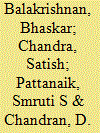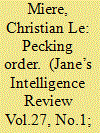|
|
|
Sort Order |
|
|
|
Items / Page
|
|
|
|
|
|
|
| Srl | Item |
| 1 |
ID:
136579


|
|
|
|
|
| Summary/Abstract |
The article examines the reasons behind the Aquino administration’s instantaneous
support for the Obama administration’s pivot to Asia as the Philippines negotiated
and signed a framework agreement on enhanced defense cooperation with the United States. This outright backing stems from President Aquino’s determination to counter China’s expansionism in the South China Sea. The 2012 Scarborough Shoal stand-off between the Philippines and China has validated the immediacy of this security arrangement which jibes with the U.S. strategic policy. In conclusion, the article contends that a small power like the Philippines—when confronted by an emergent and potentially expansionist power—is not necessarily helpless since it has foreign policy choices, as well as the power to chart its own destiny.
|
|
|
|
|
|
|
|
|
|
|
|
|
|
|
|
| 2 |
ID:
134828


|
|
|
|
|
| Summary/Abstract |
Usually when the massive plates that float over the Earth’s molten core collide, the intense pressure over millions of years pushes the land upward. It is this force that has created some of the world’s most breathtaking mountain ranges. About 80 million years ago, for some reason, when the Asian plates encountered the African and European plates this wasn’t the case. Instead of the earth lurching upwards towards the sun, the plates separated, creating the volatile Syrian East African Rift Valley: A valley that includes the world’s lowest point — the Dead Sea — 427 meters below sea level.
|
|
|
|
|
|
|
|
|
|
|
|
|
|
|
|
| 3 |
ID:
136787


|
|
|
|
|
| Summary/Abstract |
The optimist views South Asia as a half-full glass while the pessimist views it as half-empty. The realist, however, drinks the water in the glass, and wisely quenches his thirst. If we remain stuck in a quagmire of despondency over runaway population growth, grinding poverty of a huge section of the population, and endless squabbles over historic wrongs, the future looks grim. But, if we think of the region as overwhelmingly youthful, charged with vitality and a can-do mentality, well-integrated into the global economy thanks to its large diaspora, brilliantly positioned between the energy rich West Asia and the manufacturing hub of East and South-East Asia, and fully committed to inclusive developmental goals, then South Asia can be the region of the future.
|
|
|
|
|
|
|
|
|
|
|
|
|
|
|
|
| 4 |
ID:
136786


|
|
|
|
|
| Summary/Abstract |
Evolving geopolitical realities are shaping the India-Japan relationship. While the ‘China threat’ theory and declining US influence in the region is making Abe explore alternatives like India, India is expected to pursue its quest for multi-polarity, great power identity, as well as pragmatically engage with all the important players in the fast altering security environment to ensure regional peace and stability so critical for facilitating development. Japan is vital in India’s Look East, Engage East, and Act East policies. Shared values and a convergence of interests in the post-Cold War era, as discussed earlier, has pushed the relationship from one of mutual reluctance to deep-rooted trust and cooperation.
|
|
|
|
|
|
|
|
|
|
|
|
|
|
|
|
| 5 |
ID:
136779


|
|
|
|
|
| Summary/Abstract |
The coming to power of a majority government led by the BJP and Prime Minister Narendra Modi opens up new possibilities in India’s foreign policy and external relations. India’s engagement with the outside world has lagged during the past five years, hamstrung by a weak coalition government preoccupied with managing internal cohesion and keeping afloat. This drift has been apparent in internal governance as well, with decisions on many key issues left dangling. The negative impact of this on economic growth, internal security and national morale has greatly diminished India’s role in the increasingly complicated and competitive global environment.
|
|
|
|
|
|
|
|
|
|
|
|
|
|
|
|
| 6 |
ID:
135064


|
|
|
|
|
| Summary/Abstract |
This article draws on literature, media reports official Mongolian press releases and statements and a number of informal interviews and discussions with Mongolian policymakers and politicians.
Mongolia’s unique relationship with and access to the DPRK’s leadership has primarily proven to be a most valuable asset in boosting Mongolia’s profile in the region and the world at large. Whether Mongolia can spearhead a regional security mechanism, as suggested by both Mongolian politician and international analysts remain to be seen.
|
|
|
|
|
|
|
|
|
|
|
|
|
|
|
|
| 7 |
ID:
136673


|
|
|
|
|
| Summary/Abstract |
Since coming to power in May 2014, Indian Prime Minister Narendra Modi has undertaken, through a series of high profile foreign visits as well as by hosting many foreign dignitaries, a dynamic and ambitious diplomatic campaign. This is aimed at making India a keystone of the emerging multipolar world order, keeping good and fruitful relations with all sides and promoting the country's economic and strategic interests, while raising its cultural influence and prestige. ASEAN, Australia, China, Israel, Japan, Russia, neighbouring SAARC nations, Pacific Islands states and the US have all been given special attention, though Europe so far seems to have taken a backseat in priorities. Major challenges facing the world community today are international Islamic militancy and the renascent Cold War between the West and a Russo–Chinese alliance.
|
|
|
|
|
|
|
|
|
|
|
|
|
|
|
|
| 8 |
ID:
136371


|
|
|
|
|
| Summary/Abstract |
to the Asia-Pacific region have underlined the country’s dominance. Christian Le Miere assesses whether China can tip the balance against the United States political influence
|
|
|
|
|
|
|
|
|
|
|
|
|
|
|
|
| 9 |
ID:
134249


|
|
|
|
|
| Summary/Abstract |
Australia's relations with its neighbours in the South Pacific challenge theories of international relations and foreign policy analysis. Most existing analysis eschews an explicitly theoretical approach in favour of empirical description and ‘common sense’ explanations. Yet repeated patterns of interaction suggest that there is scope for developing a more theoretical understanding of the relationships between Australia and the Pacific islands. Moreover, lying at the margins in several dimensions of interstate relations, these relationships test theories and thus provide a basis to delimit or refine them. This article explores three important ways in which theories of international relations and foreign policy analysis and the study of Australia–Pacific island relations can benefit each other. First, Pacific island resistance to the projection of Australian power tests theories about the tactics available to ‘micro-powers’. Australia's frequent reorientation of and regular distraction from its approach to the Pacific islands provide evidence about ‘under-institutionalised’ policy making. Finally, the interaction of Australia's global ‘middle power’ status with its regional dominance challenges ideas of ‘middle power leadership’ and ‘strategic personalities’. These three insights lead to novel hypotheses about the conduct of foreign policy by non-great powers under conditions of extreme asymmetry.
|
|
|
|
|
|
|
|
|
|
|
|
|
|
|
|
|
|
|
|
|